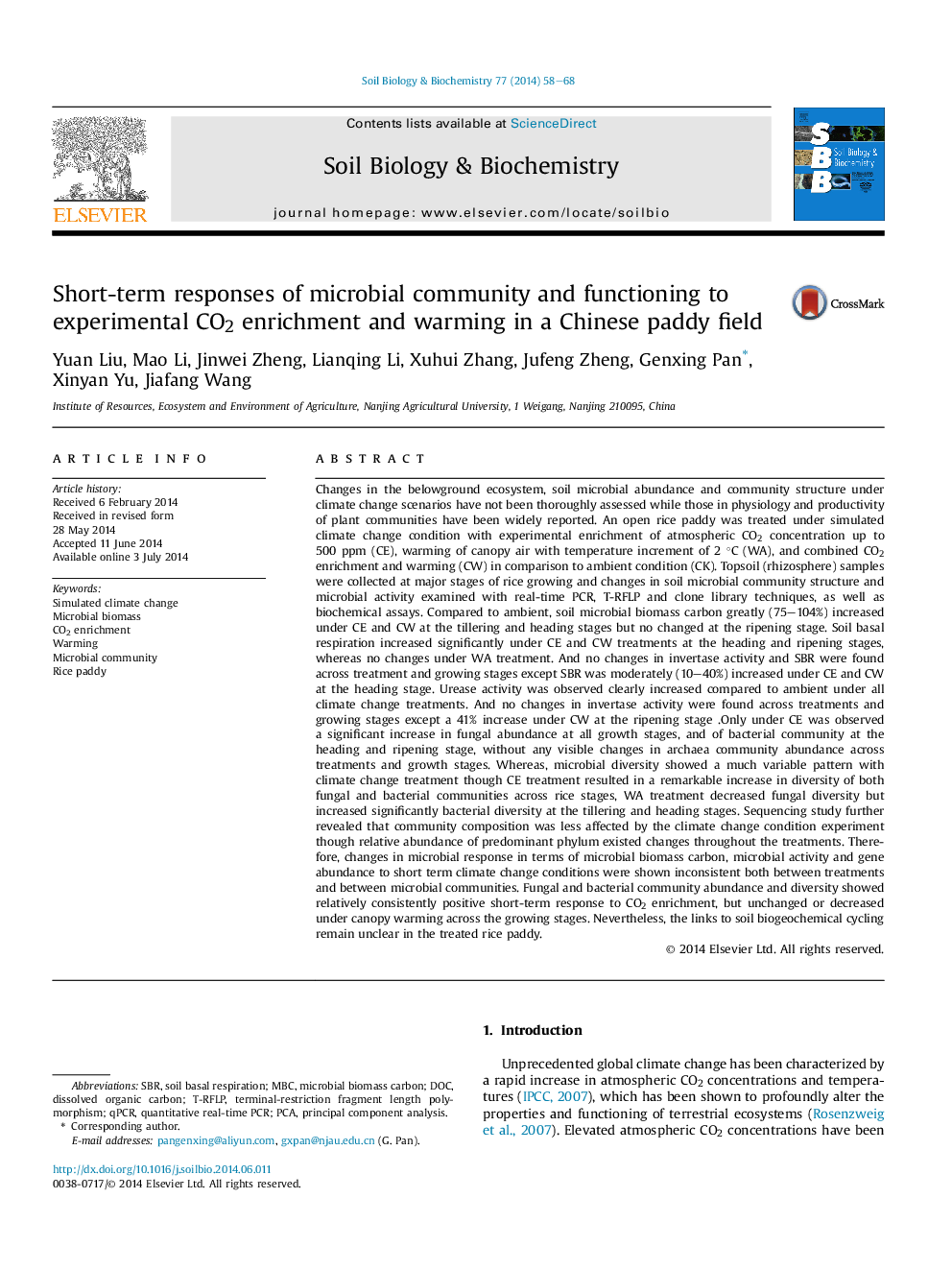| کد مقاله | کد نشریه | سال انتشار | مقاله انگلیسی | نسخه تمام متن |
|---|---|---|---|---|
| 8364467 | 1542607 | 2014 | 11 صفحه PDF | دانلود رایگان |
عنوان انگلیسی مقاله ISI
Short-term responses of microbial community and functioning to experimental CO2 enrichment and warming in a Chinese paddy field
ترجمه فارسی عنوان
پاسخهای کوتاه مدت جامعه میکروبی و عملکرد به غنیسازی و گرم شدن دوگانه آزمایشی در یک میدان چینی
دانلود مقاله + سفارش ترجمه
دانلود مقاله ISI انگلیسی
رایگان برای ایرانیان
کلمات کلیدی
qPCRT-RFLPDOCMBCSBRPCA - PCARice paddy - برنج برنجMicrobial biomass - بیوماس میکروبیPrincipal component analysis - تحلیل مولفههای اصلی یا PCASoil basal respiration - تنفس پایه خاکMicrobial community - جامعه میکروبیCO2 enrichment - غنی سازی CO2quantitative real-time PCR - واکنش زنجیره ای پلیمراز واقعی در زمان واقعیTerminal-restriction fragment length polymorphism - پلیمورفیسم طول قطعه محدودیت ترمینالDissolved organic carbon - کربن آلی حل شدهmicrobial biomass carbon - کربن زیست توده میکروبیWarming - گرم شدن
موضوعات مرتبط
علوم زیستی و بیوفناوری
علوم کشاورزی و بیولوژیک
دانش خاک شناسی
چکیده انگلیسی
Changes in the belowground ecosystem, soil microbial abundance and community structure under climate change scenarios have not been thoroughly assessed while those in physiology and productivity of plant communities have been widely reported. An open rice paddy was treated under simulated climate change condition with experimental enrichment of atmospheric CO2 concentration up to 500 ppm (CE), warming of canopy air with temperature increment of 2 °C (WA), and combined CO2 enrichment and warming (CW) in comparison to ambient condition (CK). Topsoil (rhizosphere) samples were collected at major stages of rice growing and changes in soil microbial community structure and microbial activity examined with real-time PCR, T-RFLP and clone library techniques, as well as biochemical assays. Compared to ambient, soil microbial biomass carbon greatly (75-104%) increased under CE and CW at the tillering and heading stages but no changed at the ripening stage. Soil basal respiration increased significantly under CE and CW treatments at the heading and ripening stages, whereas no changes under WA treatment. And no changes in invertase activity and SBR were found across treatment and growing stages except SBR was moderately (10-40%) increased under CE and CW at the heading stage. Urease activity was observed clearly increased compared to ambient under all climate change treatments. And no changes in invertase activity were found across treatments and growing stages except a 41% increase under CW at the ripening stage. Only under CE was observed a significant increase in fungal abundance at all growth stages, and of bacterial community at the heading and ripening stage, without any visible changes in archaea community abundance across treatments and growth stages. Whereas, microbial diversity showed a much variable pattern with climate change treatment though CE treatment resulted in a remarkable increase in diversity of both fungal and bacterial communities across rice stages, WA treatment decreased fungal diversity but increased significantly bacterial diversity at the tillering and heading stages. Sequencing study further revealed that community composition was less affected by the climate change condition experiment though relative abundance of predominant phylum existed changes throughout the treatments. Therefore, changes in microbial response in terms of microbial biomass carbon, microbial activity and gene abundance to short term climate change conditions were shown inconsistent both between treatments and between microbial communities. Fungal and bacterial community abundance and diversity showed relatively consistently positive short-term response to CO2 enrichment, but unchanged or decreased under canopy warming across the growing stages. Nevertheless, the links to soil biogeochemical cycling remain unclear in the treated rice paddy.
ناشر
Database: Elsevier - ScienceDirect (ساینس دایرکت)
Journal: Soil Biology and Biochemistry - Volume 77, October 2014, Pages 58-68
Journal: Soil Biology and Biochemistry - Volume 77, October 2014, Pages 58-68
نویسندگان
Yuan Liu, Mao Li, Jinwei Zheng, Lianqing Li, Xuhui Zhang, Jufeng Zheng, Genxing Pan, Xinyan Yu, Jiafang Wang,
